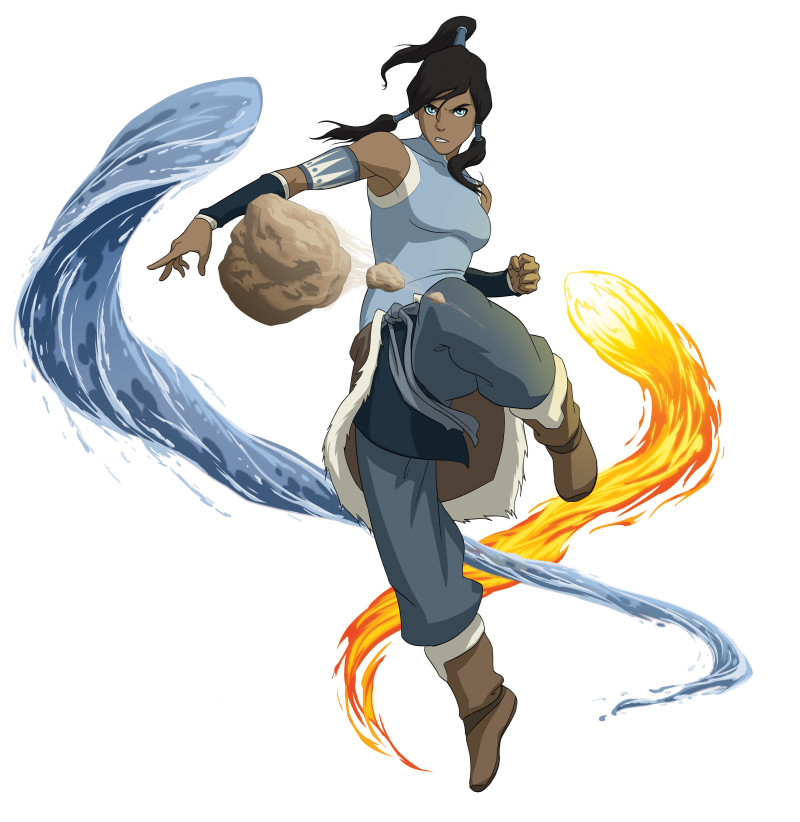Skills
The Skills of Korra
Discuss this post:
On the forums!
On Reddit!
We’ll get to Korra in a second, but first we’ve got a little housekeeping to do! First off, we’ll be doing a new feature over on the Youtube Channel called “Q&A Tuesday,” where I answer questions you guys have about, well, anything! Go throw your question up on the forums if you’d like to see it answered next week! Secondly, I’m trying something new…
Email subscribers will get an exclusive article tomorrow evening on How to Enter Your Own Avatar State! Get in on the action by joining the mailing list here!
This is part of a new initiative I’m starting to try to add even more value to joining the mailing list (besides regular blog updates and two free ebooks). If you haven’t joined up yet, make sure you do!
So, with all that out of the way, let’s get down to business. We’re going to talk a lot about martial arts and bending styles today, as well as the differences between traditional martial arts and combat sport arts (like how Korra needed to learn from both traditional teachers and pro bending teams). First off, let’s look at bending styles and what traditional real-world arts they’re rooted in!
Water Bending – Tai Chi
Tai chi is traditionally a very graceful, flowing martial art, renowned for its meditative qualities. In relation to other arts, tai chi is considered an “internal” art, one that is focused on balancing your chi (inner energy) as well as your own physical balance. Now, I’m not going to get into the whole “chi” debate yet, but I will say that the cool thing about tai chi is that if you speed up the movements, there are a lot of practical martial arts and self defense moves to be discovered in its forms.
Air Bending – Baguazhang
Baguazhang is another internal art, like tai chi, focused strongly on internal balance. It’s noted for its very circular motions and flowing movements. Something that isn’t touched on too much in the show for the air benders, is that bagua practitioners are usually very adept in multiple weapons, from staves to deer horn knives. They also use small knives, large sabers, and generally everything in between. The essence of bagua is using circular movements to flow around your opponent, and keep them away from your center (out of your circle), while moving around and attacking their center (penetrating their circle).
Earth Bending – Hung Gar Kung Fu
Hung gar is a much more “external” art, focusing on concussive force and powerful attacks to best an opponent. It’s full of deep stances, powerful movements, and heavily committed attack patterns. The internal concepts of Hung Gar are based on the idea of staying deeply connected to the earth (appropriate, eh?) through wide, heavy-set stances and powerful movements.
It’s also worth noting, here, that Toph’s style of earth bending is an exception here, it was designed and based on Southern Praying Mantis. Southern Praying Mantis uses less footwork and big leg movements than Hung Gar, and focuses more on quick, powerful movements with the upper body.
Fire Bending – Northern Shaolin Kung Fu
Northern Shaolin is a very externally oriented style, focused on quick attacks, powerful strikes, and lots of movement. It’s typically a very aggressive style, featuring empty hand movements and forms, as well as some weapons. Since Northern Shaolin is a very externally oriented art, traditional instructors usually also school themselves and their students in an internal style to accompany it, like qigong or tai chi.
External Vs. Internal
So we may stir up a bit of controversy here, but I’m going to come right out and say it…I don’t believe in “chi.” At least, chi as purported by the majority of media, legends, and other various popular culture sources. I do believe in internal psychological balance, and I do believe that there is a LOT of value to be had in practicing traditional internal styles (like tai chi), however I do not believe that you’re ever going to defend yourself by using your chi to manipulate your opponent’s chi, or whatever. Any time someone claims to be doing something through “chi” manipulation, it’s usually either basic body mechanics (how the body moves/functions) or neuro-mechanics (how nerves function.)
In my martial arts practices and learnings, I have been knocked out in one touch, but it was by an eighth degree black belt who is ALSO a neurosurgeon, who told me the exact scientific reasons for why it worked, and how it had nothing to do with chi. I’ve done unbendable/breakable arms/finger exercises, being instructed by a sports medicine doctor who told me exactly why my joints were doing what they were doing.
I’m not saying you do or don’t have to believe in chi. All I’m doing is getting my biases out there, and telling you that I personally am not going to instruct you in anything that I personally don’t believe and/or practice (and this is the same reason we never cover occult/magick stuff here.) Your beliefs are entirely up to you, and I do not begrudge you for them.
Traditional Vs. Modern Sport
Okay, now time to ruffle some more feathers! I think anyone who trains exclusively in traditional martial arts will lose a fight to someone who trains in equivalent modern combat sports at least seven times out of ten, assuming all else (size, weight, level of fitness) being equal. Why is this? Well, a multitude of reasons, the first of which being live sparring.
Traditional martial arts usually either don’t spar, they don’t spar with pads, they only do “point” sparring, and they never practice heavy contact. This isn’t to say you have to go knock each other around at the dojo/dojang/gym every time you go (heavy sparring on a regular basis is actually pretty bad for you), but if you never get hit, you will never learn how to recover from a hit, or escape from a combo. This is also part of the issue with point sparring, in that a point sparring match usually stops the second someone gets a shot in, whereas in a real fight, that’s usually when the actual fight starts.
Secondly, traditional martial arts are usually mired in, well, tradition. I see this a lot, even in a relatively modern art like my own Isshinryu Karate. I have been blessed with very non-traditional instructors, in karate, judo, and even my kung fu and tai chi practices. That said, in my relation with other schools, I see a lot of people who stick to what they’re doing just because it’s what they’ve always done, rather than learning and adapting from what other arts and styles bring to the table. Fighting is like life. If you don’t adapt, you die.
To bring this all back to Korra, Korra found herself at a disadvantage while first engaging in pro bending. If you watch pro bending vs. traditional bending, you find a lot of similarities between modern vs. traditional arts. Pro benders have more upright, narrow stances (better for rapid footwork and movement), they keep their hands up, covering themselves (less openings for attack, quicker recovery from defense), and they focus on fast, easily-entered combinations, rather than going for the single punch knock out every time.
The thing that Korra does, and the thing that we all have to do, too, is take what we can from our different sources. Traditional martial arts definitely have a lot to offer, still! You can see this in UFC greats who studied traditional arts, like Georges St. Pierre (kyokushin karate), Ronda Rousey (kodokan judo), and Lyoto Machida (shotokan karate). Traditional martial arts feature all kinds of awesome self defense moves that you could never use in the ring (eye gouges, joint smashes, pressure point control). However, you also have to take the strengths of modern sport arts into account, like live contact sparring. Unless you use a move, you have no idea what’s actually going to work in combat (everything looks awesome when you’re fighting the air, or a wooden board).
Like Korra (and Aang before her!), if you want to become a truly proficient martial artist, you have to take what works, and use it, and discard what doesn’t. Let go of your predetermined notions, and keep your mind open to new ways.
Using the Elements
Speaking of drawing from what works, let’s talk about drawing from the elements. Now, I wish I could teach you how to make the natural elements do what you want with awesome kung fu moves, but the fact is, I can’t. But, we can still draw from elemental inspiration. Bruce Lee is famous for his “be like water,” speech, and drawing ideas and principles from elemental sources is a very legitimate way of “bending” your own ideas and concepts in fighting.
You don’t have to study the arts listed above to still apply those bending principles to whatever arts you do study. For instance: even though I’ve studied some kung fu and tai chi, I am a karate and judo guy at heart. However, I am also a fire bender at heart. As such, I apply fire-bender type principles to my own combat style. I value fast, powerful attacks, quick footwork, and rapidly chained combinations. I like to maneuver quickly, and either overwhelm my opponents with speed and force, or react quickly in my counters with rapidly chained combinations.
If you find yourself to be more aligned with earth bending, then you want to focus more on making your opponent work around you, blunting themselves against your own solid defense, and then using strength and powerful attack vectors to smash through their defense.
If you’re a water bender, you want to focus on counters and smooth motion. Redirecting your opponent’s force should be your signature style, and you should adapt to and fill every opening your opponent gives you, while absorbing and redirecting any attacks they throw at you.
Air benders focus on the art of not being there until they have to be. In your practices, you should be focused on avoiding, dodging, and countering swiftly. You want to make your opponent feel as if you don’t even exist, like trying to hit air, until the moment you counter-attack.
Applying principles of elements to your own combat styles give you more creativity to draw upon in crafting your own style, regardless of what martial arts you study. Make it your own.
That’s it for the skills of Korra! Don’t forget, mailing list subscribers will get an exclusive bonus article tomorrow about unlocking your own Avatar state, so make sure you sign up if you’re not already on the list!
I’ll see you again on Thursday, with The Mind of Korra. Live boldly, change the world, and continue to be awesome!
Dan “DaRatmastah” Wallace






Like the post Dan
Thanks! =D
Pingback: Character Spotlight: Korra | Be a Game Character